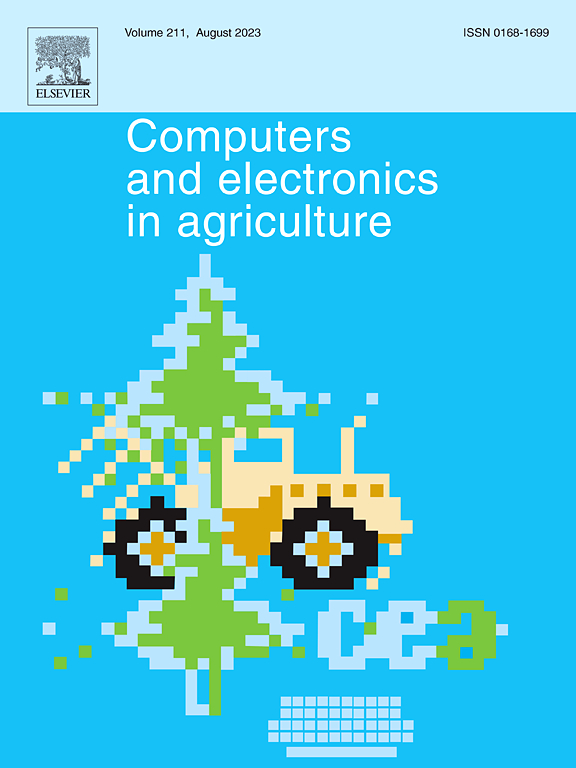使用皮毛图案进行个体牛识别的深度度量学习:最佳实践建议
IF 8.9
1区 农林科学
Q1 AGRICULTURE, MULTIDISCIPLINARY
引用次数: 0
摘要
有效的单头牛识别对精准畜牧业(PLF)至关重要,特别是通过在不受限制的环境中远程识别来管理生长和改善动物福利。本研究提出了一种最佳实践,一种系统的训练和超参数优化策略,以识别最佳性能模型,用于使用基于皮毛图案的直接深度度量学习(DML)结构识别单个牛。提出的最佳实践是使用开放获取无人机(UAV) rgb数据集开发的,并在地面rgb数据集上进行了验证。作者提供的两个数据集都来自中国一个商业农场的96只半散养西蒙塔尔雄性肉牛群,但分别使用不同的平台捕获:无人机和固定框架。研究还评估了半硬开采技术对DML性能的影响。利用最佳实践对两个数据集进行优化模型分析,结果表明,站姿牛的表现略好于不同姿势(包括站姿和躺姿)的牛,累积匹配特征在1级时提高了1.41% (CMC@1)。然而,这两种最优模型都显示出与最新研究相当的性能。当在公开可用的open奶牛2020(品种:Holstein Friesian)数据集中测试最佳实践的通则性时,最优模型取得了显着的结果,CMC@1和CMC@5均为99.80%,平均平均精度(mAP)为99.67%,超过了使用相同数据集的先前研究。这些结果证实了所提出的最佳实践在个体牛识别的准确性和普遍性方面的有效性,并为类似的生物特征识别任务(例如使用面部图像进行个体识别)提供了有价值的见解。本文章由计算机程序翻译,如有差异,请以英文原文为准。

Deep metric learning for individual cattle identification using coat patterns: Proposal for a best practice
Effective individual cattle identification is crucial for Precision Livestock Farming (PLF), particularly in managing growth and improving animal welfare through remote identification in unconfined environments. This study proposes a best practice, a systematic strategy for training and hyperparameter optimisation to identify the optimal-performing model, for the identification of individual cattle using a straightforward Deep Metric Learning (DML) structure based on coat patterns. The proposed best practice was developed using the open-access Unmanned Aerial Vehicle (UAV)-RGB dataset and validated on the Ground-RGB dataset. Both datasets, contributed by the authors, were obtained from the same semi-free-range Simmental male beef cattle herd of 96 individuals on a commercial farm in China but were captured using different platforms: UAV and stationary frames, respectively. The study also evaluates the impact of the semi-hard mining technique on the performance of DML. Analysis of the optimal models derived by using the best practice for the two datasets indicates that cattle in standing postures yield slightly better performance than those with diversity in postures, including both standing and lying, with a 1.41% improvement in Cumulative Matching Characteristic at rank 1 (CMC@1). However, both optimal models demonstrate performance comparable to that in state-of-the-art studies. When the best practice was tested for generalisability in the publicly available OpenCows2020 (breed: Holstein Friesian) dataset, the optimal model achieved remarkable results, with the CMC@1 and CMC@5 both at 99.80% and the mean Average Precision (mAP) at 99.67%, surpassing previous studies using the same dataset. These results confirm the effectiveness of the proposed best practice in terms of accuracy and generalisability for individual cattle identification and offer valuable insights for similar biometric identification tasks, such as individual identification using facial images.
求助全文
通过发布文献求助,成功后即可免费获取论文全文。
去求助
来源期刊

Computers and Electronics in Agriculture
工程技术-计算机:跨学科应用
CiteScore
15.30
自引率
14.50%
发文量
800
审稿时长
62 days
期刊介绍:
Computers and Electronics in Agriculture provides international coverage of advancements in computer hardware, software, electronic instrumentation, and control systems applied to agricultural challenges. Encompassing agronomy, horticulture, forestry, aquaculture, and animal farming, the journal publishes original papers, reviews, and applications notes. It explores the use of computers and electronics in plant or animal agricultural production, covering topics like agricultural soils, water, pests, controlled environments, and waste. The scope extends to on-farm post-harvest operations and relevant technologies, including artificial intelligence, sensors, machine vision, robotics, networking, and simulation modeling. Its companion journal, Smart Agricultural Technology, continues the focus on smart applications in production agriculture.
 求助内容:
求助内容: 应助结果提醒方式:
应助结果提醒方式:


